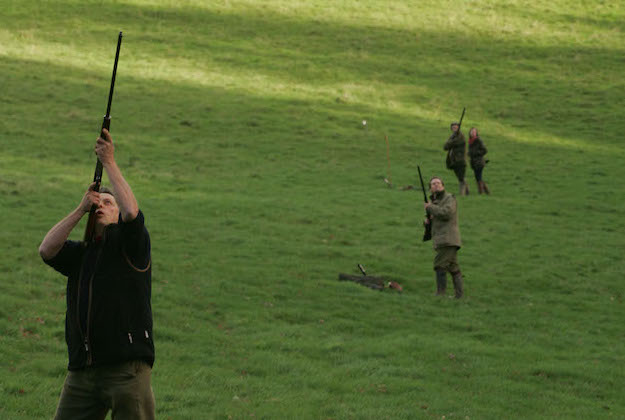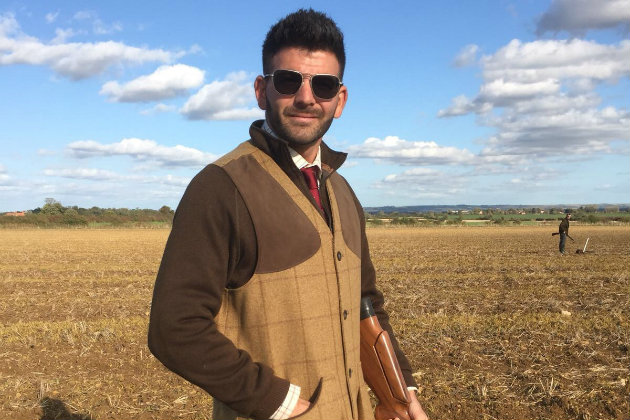Which is the best shotgun cartridge for hitting high birds?
I noticed something last season. I saw some fellow Guns shooting birds at extreme range – higher than 60 yards…
Win CENS ProFlex DX5 earplugs worth £1,149 – enter here
 The Kitchen Garden drive on Cothelstone -the second drive of the day
The Kitchen Garden drive on Cothelstone -the second drive of the day
January has come round again and that means it’s high pheasant time. So we asked around some Guns and shooting instructors of our acquaintance to see what ammunition they used and for any tips they had to share.
“Truly high pheasant shooting needs the right gun and cartridge combination. My gun preference would be a 12g with 32” barrels and cartridges for the really high ones 34 / 35 gram 4’s or 5’s. Footwork, timing, line and lead are the ingredients to deliver the right result and of course correct reading of what the bird is doing in terms of line, lead and speed. And of course don’t under estimate the amount of concentration required to put it all together. Regular practice and guidance with an instructor will help build your confidence for the day.” Mark Heath, Instructor Manager at West London Shooting School.
“High birds are objective, high birds for one gun may be medium birds for another. Having the right set up for the birds you are shooting at is the key. The gun, choke and cartridge combination I use for high birds has been tested and I have confidence in its performance.
Over the last couple of years, the demand for high birds has increased, and shoots are trying to present the best birds they can. But I am seeing guns using big loads and tight chokes when it’s not really necessary, it can also have a negative effect on your pattern.” Tony Bracci, shooting instructor Bisley
“When shooting high pheasants remember to move your feet, and wherever possible turn them into crossers so that you can measure your lead. They always need more lead than you think! The key is to make sure your gun fits you, I use a Browning B725, 30” barrels choked ¾ and full, and Hull High Pheasant Extreme 32g No. 5 cartridges. The choke matters as you need some choke for pattern retention, ensure you have pattern tested to your preferred choke. Height is quite a personal matter, for some a high pheasant is a 60-70-yard bird – shooting very high pheasants requires a specific skillset and is something that has to be learned. It’s not something that everyone can do, and it isn’t to everyone’s tastes, but those that are specialists turn it into an art form.” Marcus Janssen, Brand Director at Schöffel Country.

Ed Solomons
“I class anything over 40 yards a high bird personally, there are few people that realise just how high that is straight up! For high pheasants, I use tighter chokes, and a larger shot- 34g No.4 Hull HPX as a minimum and through ½ or ¾ choke.” Farlows brand ambassador, leading shooting coach and industry thought leader, Ed Solomons
“Hull 30g No. 5 are my go-to cartridge, as they’re the perfect all-rounder! I use my incredibly beautiful 1922 Holland and Holland Royal self-opening 12 bores, which I am hugely lucky my step-father gave to me. Light, versatile, reliable, I could not ask for a better gun!” Ted Innes Ker, founder of Scotland’s bespoke travel specialist, Reiver Travel
“When I arrive at my peg and look up to see terrain that promises good high sporting pheasants I feel most confident with a correctly fitted 12 bore over-and-under with at least 30” barrels and a minimum of half and preferably three quarters regulated fixed choke or precision multi-chokes.
Over time I have learnt that I can trust a 32g fibre wadded Hull cartridge loaded with 5’s and that this combination exceeds my capabilities, so happily select birds no further than 55-60yds.
I would also have made sure to have had some high tower clay practice to help ensure the all-important follow through, footwork and turn.” Christopher Bird, chief instructor, Holland & Holland
“I’ve never been on a shoot where the pheasants are stratospherically high. A high bird for me ranges from about 50 to 70 metres. If I get a clean kill at that range I am happy. Birds at 150 meters are beyond my ability – I will admit that.”
When it comes to cartridges I usually use Hull High Pheasant Extreme no.5 shot in either a 30g or 32g load. They give minimal recoil, have a lot of hitting power and they don’t foul my barrels, making gun cleaning easy. Naturally I would always choose a biodegradable fibre wad version. Combined with my 12-bore Browning XS Pro with 32-in barrels, this makes for a great high pheasant combination.
My only bit of advice would be not to get hung up on chokes. My gun is fitted with 1Ž4 and 1Ž2 and I use that for everything. As a friend once told me, “Don’t keep changing choke; just learn to point the gun in the right direction.” Matt Clarke, Editor Sporting Gun
I noticed something last season. I saw some fellow Guns shooting birds at extreme range – higher than 60 yards…
Lady’s Wood Shooting School provides the host setting for a masterclass on shooting high birds. As instructor Tom Payne advises:…
Chris Bird at Hollands offers some high pheasant shooting tips
“I use our EJ Churchill Hellfire cartridges. They are specifically designed by Gamebore and exclusive to us. They are fibre wad and copper coated lead shot (which is done by Gamebore in house, to ensure perfection with the quality). They are VERY hard hitting but soft on the shoulder due to all the testing we do with them and working with Gamebore to make them the very best cartridge. I use a 34g no. 5 shot for the high stuff (50yd – 70yd). Gun-wise I use an EJ Churchill Perazzi sideplate with 30” barrels and ¾ and ¾ chokes. I use these guns for everything and I love them. They balance beautifully and more importantly are reliable and work well no matter how much hammer they get! “ Rob Fenwick, Managing Director, EJ Churchill
Get the latest news delivered direct to your door
Discover the ultimate companion for field sports enthusiasts with Shooting Times & Country Magazine, the UK’s leading weekly publication that has been at the forefront of shooting culture since 1882. Subscribers gain access to expert tips, comprehensive gear reviews, seasonal advice and a vibrant community of like-minded shooters.
Save on shop price when you subscribe with weekly issues featuring in-depth articles on gundog training, exclusive member offers and access to the digital back issue library. A Shooting Times & Country subscription is more than a magazine, don’t just read about the countryside; immerse yourself in its most authoritative and engaging publication.

